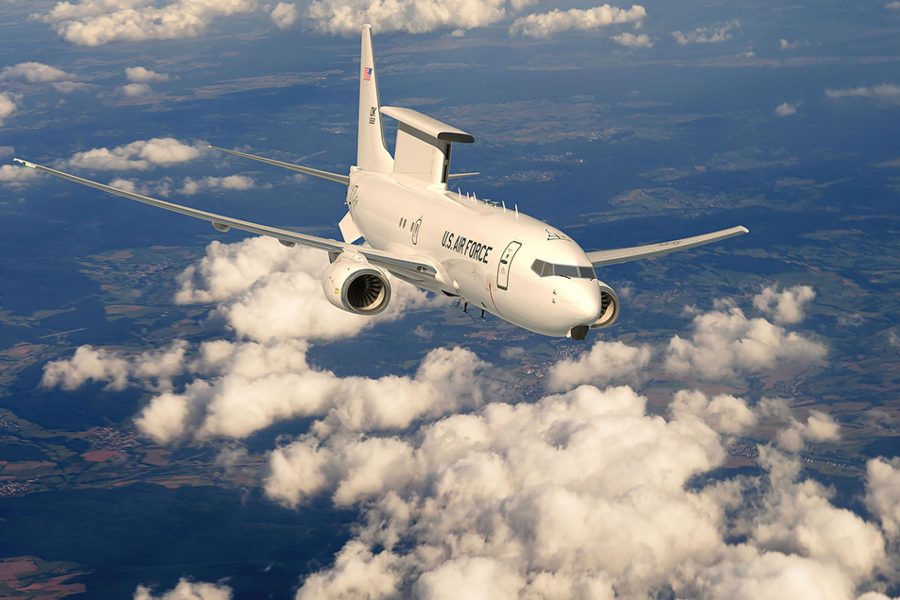The Air Force is still a few years away from getting its hands on its first E-7 aircraft for airborne early warning and control, but the service is already seeking industry input on new systems to either enhance or replace the sensor capabilities of the Wedgetail—or possibly even acquire new capabilities for an entirely different targeting and battle management platform.
The plan is to start an engineering and manufacturing effort in fiscal 2027, around the same time as the first E-7 gets delivered.
In an April 15 solicitation, the Air Force explained that the first few E-7s are being acquired under a rapid prototyping program to cover “urgent capability gaps” caused by obsolescence and diminishing availability of the E-3 Sentry AWACS fleet. But in order to go fast, “the government intentionally did not include emerging new capabilities” in the program. Now it is interested “in identifying industry partners to provide cutting-edge capabilities and technologies.”
The Air Force’s Wedgetail Advanced Capabilities branch at Hanscom Air Force Base, Mass., issued the solicitation.
“Following the EMD phase, the Government is considering retrofitting USAF E-7A aircraft with EMD modifications, producing new E-7 aircraft, or a combination of retrofit and new aircraft,” the Air Force said.
Among the E-7 capabilities the Air Force is looking to either improve or replace are:
- The E-7’s distinctive Multi-role Electronically Scanned Array radar
- Advanced infrared sensors
- Electronic Support Measures (ESM) replacement
- Electronic Warfare Self-Protection (EWSP) replacement
- Tactical Targeting Network Technology (TTNT)
- Link 16 High Power Amplifier (HPA)
- Joint Worldwide Intelligence Communications System (JWICS) connectivity
- Combat Identification (CID)
- Next-generation Tactical Data Link (TDL)
- Advanced missile data link capabilities
- Other next-gen tech for battle management, command and control, targeting, communications, or position, navigation, and timing.
Notably, the Air Force solicitation states that it wants the technology around 2027 to start integrating onto “the baseline E-7 platform, or an equivalent AMTI/BMC2 platform.”
The Air Force plans to acquire 26 E-7s from Boeing by 2032, fewer than the 34 E-3s the service bought in the 1970s and ’80s. Officials have said they consider the Wedgetail a stopgap solution for the moving target indication mission, with plans to migrate the mission to space-based platforms in the 2030s. The long-term future of airborne command and control and targeting is not yet clear.
The E-7 is hosted on the 737-700 airframe, and Boeing will integrate the sensor and battle management systems the aircraft will carry. Northrop Grumman is the contractor for the large MESA radar on the top of the airframe, which vastly improves on the capabilities of the rotodome radar on the E-3.
Last August, the Air Force ordered the first two “operationally representative” E-7As under a contract worth $2.56 billion. Those aircraft are to be delivered in fiscal 2028.
There seems to be some urgency in the new solicitation, as the Air Force moved up the response date from May 7 to April 22 just a week after the solicitation was issued. That suggests that potential providers are already well aware of the Air Force’s requirements and are ready to respond.
The Air Force will require “delivery of at least two (2) integrated weapon systems (Advanced E-7 weapon system and associated ground equipment) within 7 years,” potentially starting in 2027, it said in the RFI. But it also noted that “baseline documentation for the E‑7A will not be available until [the third quarter of fiscal 2028], or potentially later. This documentation will not include detailed drawings or analyses of any commercial parts.”
Northrop Grumman is well along in testing its Electronically-Scanned Multifunction Reconfigurable Integrated Sensor (EMRIS), on which it completed its first “campaign” of test flights last year. The sensor, which can combine radar sensing functions with communications and electronic warfare, is intended to equip much smaller platforms than the E-7; Northrop sized it for use on autonomous Collaborative Combat Aircraft and fighters. This may explain the Air Force’s reference in the new solicitation to “other aircraft” that could fulfill the AMTI/BMC2 role.
